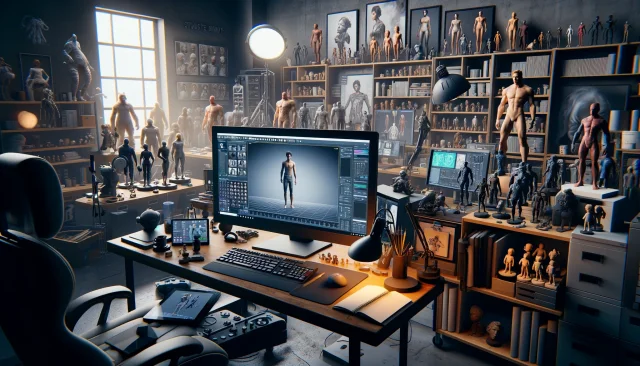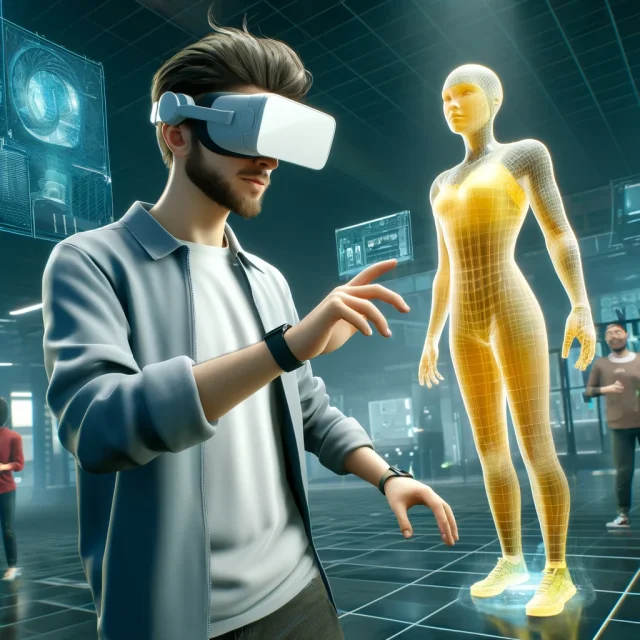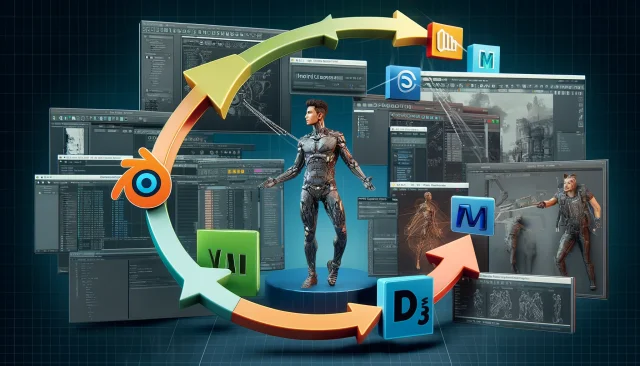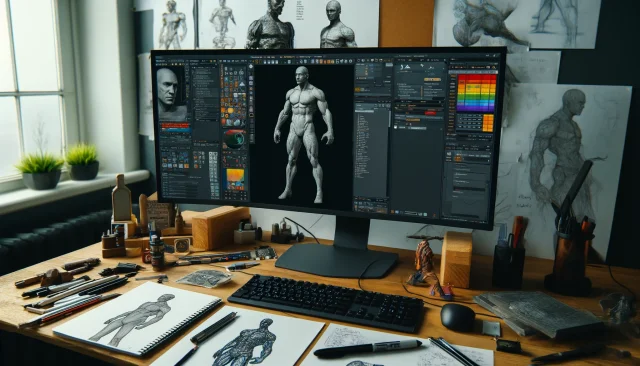Analyzing Trends in Creating 3D Characters for Films and Video Games

Analyzing Trends in Creating 3D Characters for Films and Video Games: An Overview of the Latest Technologies and Methods in the Entertainment Industry and How to Adapt These Methods for Use in DAZ Studio and Poser.
The creation of 3D characters for films and video games has become one of the most dynamically evolving areas in the entertainment industry. Modern technologies and methods applied in this field allow for the creation of characters with unprecedented levels of realism and detail. In this article, we will explore key trends and innovations in 3D character creation and discuss how these advanced methods can be adapted for use in DAZ Studio and Poser.
Photorealism and the Use of Scanning
A major trend in 3D character creation is the pursuit of photorealism. Modern films and video games often require creators to develop characters with such a high level of detail that they are almost indistinguishable from real people. This has become possible through the use of 3D scanning and photogrammetry. These methods enable the production of high-quality 3D models that accurately reproduce skin texture, facial features, and anatomical details.
In the context of DAZ Studio and Poser, the use of photorealistic textures and models is becoming increasingly popular. Users can import scanned models or use available market resources to create realistic characters. This is particularly beneficial for artists aiming for maximum realism in their work. For example, DAZ Studio supports the import of high-resolution textures and detailed morphs, which can be applied to base models to enhance their realism significantly.
3D scanning involves capturing the physical form of real-world objects, including human faces and bodies, using laser scanners or structured light scanners. This technology creates a precise digital replica that includes every minute detail of the scanned object. In the film and gaming industries, 3D scanning is often used to create digital doubles of actors, which can then be animated to perform stunts or appear in scenes that would be impossible or unsafe to film in real life.
Photogrammetry, on the other hand, involves taking multiple photographs of an object from different angles and using software to reconstruct a 3D model from these images. This method is particularly useful for capturing complex textures and details, such as skin pores and wrinkles, which can then be transferred onto 3D models.
Artificial Intelligence and Machine Learning
Another significant trend is the application of artificial intelligence (AI) and machine learning (ML) in creating 3D characters. These technologies automate many aspects of the process, such as facial animation, realistic body movements, and even the generation of unique characters based on large datasets. For example, deep learning technologies can analyze real video recordings and create animations that look natural and believable.
DAZ Studio and Poser are also starting to incorporate AI technologies. Some plugins and scripts allow for the use of AI to enhance animation and generate new models. This opens new possibilities for users, enabling them to create more complex and realistic scenes with minimal effort. For instance, AI-driven tools can be used to create lifelike facial expressions and lip-syncing for character animations, making the characters appear more engaging and expressive.
AI-based technologies, such as neural networks, can analyze vast amounts of data to learn the nuances of human motion and expression. Once trained, these systems can generate realistic animations by predicting how a character's body and face should move in response to various stimuli. This is particularly useful in creating natural-looking facial animations, where even the slightest inaccuracies can break the illusion of realism.
Virtual and Augmented Reality
With the growing popularity of virtual reality (VR) and augmented reality (AR), the demand for 3D characters that can interact with these technologies is also increasing. Characters for VR and AR need to be not only high-quality but also optimized for real-time performance. This requires a special approach to modeling, texturing, and animation.
In DAZ Studio and Poser, creating characters for VR and AR is also possible, especially with the support of modern export formats and integration with other tools. Users can create characters that can then be used in VR/AR applications, games, and interactive experiences. Optimization techniques such as reducing polygon counts and using efficient texture mapping are crucial to ensure smooth performance in real-time applications.
Physically Based Rendering
Physically based rendering (PBR) has become the standard in the industry for creating realistic materials and lighting. This method allows for a more believable appearance of objects by using light reflection models based on physical principles.
In DAZ Studio and Poser, the support for PBR materials has also significantly improved. Users can create materials that realistically react to light, achieving a higher level of photorealism. This is particularly important for those involved in creating characters for animation and games. PBR relies on accurate simulations of how light interacts with surfaces, considering factors such as roughness, metallicity, and subsurface scattering. These elements contribute to the realistic portrayal of skin, hair, clothing, and other materials in 3D characters.
Procedural Content Creation
Procedural content creation is another important trend actively used in creating 3D characters. This method allows for the automatic generation of complex models and textures, significantly saving artists' time and effort. For example, procedural algorithms can create realistic vegetation, props, environments, clothing, or even entire scenes.
DAZ Studio and Poser also provide opportunities for procedural content creation. There are scripts and plugins that allow for the automation of certain elements' creation, such as hair, clothing, or accessories. This is especially useful for those working on large projects who need quick generation of a large number of diverse objects.
Procedural generation involves using algorithms to create patterns and structures that can be easily modified by changing input parameters. This approach is highly efficient for generating repetitive or highly detailed content, such as hair strands, fabric textures, or environmental elements. In DAZ Studio, procedural shaders can be used to create complex material effects without the need for extensive manual texture painting.
Adapting Modern Technologies for DAZ Studio and Poser
While DAZ Studio and Poser may not always have all the capabilities available in professional 3D packages, they provide powerful tools for creating high-quality characters. To adapt modern technologies and methods in these programs, users can use the following approaches:
- Importing Third-Party Resources: Utilizing scanned models, textures, and other available market resources can significantly enhance the quality of created characters. For example, importing a high-resolution 3D scan of a human face can provide a highly detailed base mesh, which can then be customized and animated within DAZ Studio.
- Using Plugins and Scripts: There are numerous plugins and scripts that expand the functionality of DAZ Studio and Poser, adding support for new technologies and methods. These can include tools for advanced rigging, procedural texture generation, or real-time rendering enhancements.
- Learning and Using AI: Implementing AI technologies to automate modeling and animation processes allows for higher results with less effort. AI-based tools can be used to generate realistic skin textures, automate the rigging process, or even create entire characters based on input parameters.
- Optimization for VR and AR: Creating characters with VR and AR requirements in mind allows for their use in the most modern interactive applications. This includes optimizing characters for low-latency rendering, ensuring compatibility with VR/AR hardware, and using efficient animation techniques to maintain performance.
- Using PBR Materials: Applying physically based materials allows for a more realistic appearance of characters and scenes. This involves using texture maps such as diffuse, normal, roughness, and metallic maps to create materials that react to light in a physically accurate manner.
Conclusion
The creation of 3D characters for films and video games is constantly evolving, and modern technologies open new opportunities for artists and developers. DAZ Studio and Poser, despite their limitations, provide powerful tools for adapting these technologies and methods. Users can utilize photorealistic textures, AI technologies, procedural content creation, and other methods to create high-quality characters.
If you want to try your hand at creating 3D characters, visit our website, where you can download ready-made characters and creatures for DAZ Studio and Poser for free. This is a great opportunity to start your journey in the world of 3D modeling and animation.
Ctrl
Enter
Noticed a misTake
Highlight text and press Ctrl+EnterRelated news:

Advanced Texturing Techniques in DAZ Studio and Poser

Virtual Reality and 3D Characters: Exploring the Possibilities of Creating 3D Characters for VR Projects with DAZ Studio and Poser, and Necessary Adaptations for VR

Modern methods of creating animations for game characters

Integration of DAZ Studio and Poser with Other 3D Packages: Discussion of Import and Export Processes and Techniques

Character creation process in DAZ Studio and Poser for game projects: nuances and features

Creating and Rendering Hair and Clothing in 3D: Best Practices
Comments (0)
